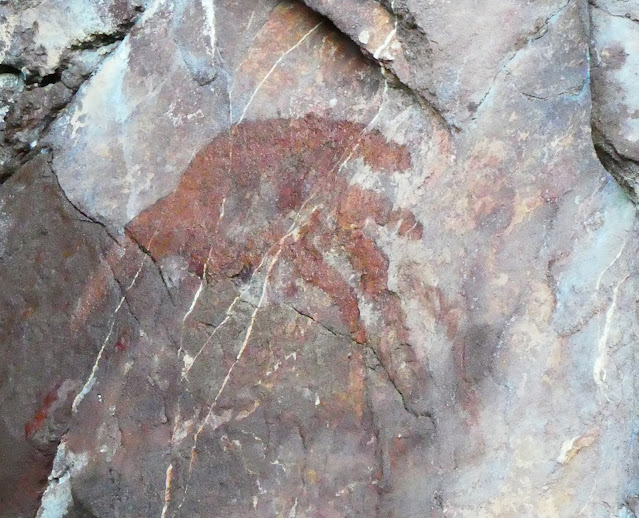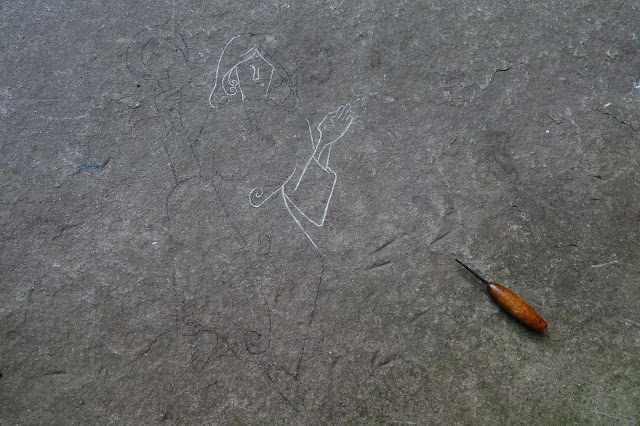Visual concepts, sketches, ideas created up to the end of Semester 2 as preparatory work and visual aids. These can then be compared to the ongoing Semester 3 work on the home page.
 |
Earliest attempts at rendering a couple of the characters: too obvious, illustrative, story-book. Too easy.
|
From the outset I realised that simply creating an epic, heroic poem starring cat-people, wolf-people, gods and dragons, and producing accompanying artwork, wasn't going to work for a Master's. The starting point was the landscape and visual representation around me - in Pictish Angus - and I made several trips to the nearby Aberlemno stones to study them at first hand (again):
 |
References to various styles and forms of representation, for reconsidering the entire visual approach to the work
|
 |
| Thinking beyond the box - and the text - considering a 'piece of jewelry' from the mythical world, first visualized as an ouroborus piece (brooch?) then a snakey ring. Covid = unpredictable workshop access = no. Would have been a good collab though. | |
|
 |
First attempt at rendering one of the major gods in an 'illuminated manuscript' style - Hrefni (derived from 'raven' in OE). originally called 'Hrekk' (an onomatopaeic name really).
|
 |
Idea for a 4-way manuscript decoration.
|
 |
Other brainstormed ideas for character designs - with aims to 'signify' rather than 'represent'
|
 |
Later attempt at a raven, after the Sutton Hoo design - too parrot-ish.
|
 |
Better - more distinctive
|
 |
Double-headed raven, again channelling some of the Sutton Hoo ornamentation
|
My rendering of the Sutton Hoo dragon brooch. Dragon reference - see here. |
Cosmic beasts as supporters of both moon and sun (or full moon and new moon)
|
 |
| Design for the dog/deer/snake hybrid cosmic beast, informed by Pictish designs and the 'Questing Beast' of Arthurian romance, which has its origins in primal dismemberment myth and ritual (See Alby Stone, 'The Questing Beast & Other Cosmic Dismemberments') |

Figuring out the character of the deities attached to the lunar phases wasn't easy. Originally I had imagined the waning crescent to be 'bad' (and the waxing one to be 'good') until I realised this looked like a problematic reading of the Islamic crescent. Looking further into Middle-Eastern astronomy, I noted that the new moon is in fact highly auspicious, as is the waning crescent (its closest approach to the time of feasting, and the start of a new month). As it turned out I decided that the Moon would be the primary deity (in three distinct forms), with support from the spider trickster goddess who is also of a lunar character, via her associations with Ariadne and Arachne in Greek myth. (While the book is fundamentally a hoax, James Vogh's 'The 13th Zodiac: The Sign of Arachne' was a useful compendium of speculative lunar lore, including much of Robert Graves' ideas).
 |
| Spider references for the mythical trickster-goddess, who rescues the cat-people's progenitor from the Underworld. ref: Peterson, 'The Message of Scotland's Symbol Stones. |
|
 |
Oseburg anthropomorphics with a distinctive bird-shaman character...suggestive of Hrefni, who embodies many aspects of shamanism (as does his nearest counterpart, Odinn)
|
 |
Original concept for the hermaphrodite lunar deity Hretha - an unconscious re-working of Eliphas Levi's iconic Baphomet, a symbol of totality. Hretha embodies all phases of the moon. Three lunar deities exist in this cosmology alongside only one solar deity, to suggest the importance given to the moon in prehistoric (speculatively matriarchal) cults.
|
 |
Figuring out the gods' family tree
|
The divine family was imagined as a spectrum (from lightest (sun) to darkest (new moon)).
 |
Gydena, goddess of the sun (primarily a Celtic concept), whose name derives from OE 'gyden', 'lady'
|
The solar goddess, Gydena, is consort to the raven storm-god Hrefni. She brings fire and fertility. With her moon sisters, MAEgtha (full moon) and HAEgena (new moon) she is one of the standard matriarchal triad, in the mother-maiden-hag tradition. Hence each 'age of femininity' has its equal in the lunar cycle.
 |
Hrefni, shamanistic storm-god
|
Hrefni is Gydena's 'other half'. Like any deity he is an accomplished shape-shifter and can present as man, as bird, or any combination in between. As storm-god he has a connection to night and war, though Gydena's depiction with sword suggests he takes a more passive role in this. Their daughters, the 13 'war-wives', are suggestive of the Norse valkyrjur - 13 being the number in a traditional coven, and as minor goddesses, these 13 are themselves worshipped and invoked in sacred groves at times of strife. His shamanistic character gradually suggested that Hrefni should be a migrant from a land much like Siberia, informing the creation of a vague 'back story' for the gods as a tribe of wanderers - cosmic hunter-gatherers perhaps - or else a collection of far-travelled individuals who happened to all meet in some way. His storm-drum is of course made from the wood of Ashentorr, the primal ash-tree, as trees (and tree-climbing) have great importance in shamanistic belief (see: N. D. Isaacs, 'Up a Tree: to See the Fates of Men', in 'Anglo-Saxon Poetry: Essays in Appreciation', eds.L. Nicholson & D. Frese).

 |
Lunar warrior women at
sacred tree - mock-up for wood carving. The heroine’s close
companion is one such divine valkyrie-like priestess, though she is
outcast and unaware of her own origins for much of the text
|
 |
Ulfhednar marching war-band. Repeating border design.
|
The Ulfhednar are a nation of powerful, fierce werewolf-like people who dwell in the frozen Northern wastes where no sun ever shines, and the moon is eternal. They are, in a sense, a gross exaggeration of what 8th Century Christian propaganda of the Norsemen might have been: huge, hairy, axe-wielding monsters who glorify war and slaughter, and ravage everything in their path. While to an extent this is true of their history, it is revealed that they also have a unique tradition of art and craft, and their interactions with the leading characters is complex and nuanced throughout the epic. They practice slavery and sacrifice (like the Norsemen, and the Celts) and view humans as an inferior species suitable for both. The name Ulfhednar derives from Norse warrior-cults who wore wolfskins and, like the Berserkers, took on animalistic characteristics in battle.
They also gave their name to my music side project, which channels themes from the poem and its wider influences, and are immortalized in a track from the first demo EP:
More info on the Ulfish folk can be found here.
 |
Notes on the Celtic torc and associated symbolism
|
 |
| Sketchbook evolution of the Moon-goddess MAEgtha from the illumination of God in the OE MS Junius 11 - total reversal of the 'solar male deity'. |
|
|
|
|
|





























Comments
Post a Comment